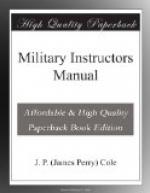1. Bend trunk
forward and backward, relaxed.
2. Breathing
exercise, as in 12.
For further work for recruits and work to be given trained soldiers, see Special Regulation No. 23, “Field Physical Training of the Soldier.”
To prevent grumbling, keep men at work. Idle men are the ones who growl. The French consider periods spent in the trenches as periods of rest; instead of letting the men go on pass when relieved, they restore discipline by close order drill.
The physical benefit is less than half of physical exercises. There should be mental exertion in every exercise. But the most important part is the disciplinary benefit. The exercises must teach men to jump at commands, and by this means must make the organization a homogeneous mass.
The principal thing in the position of attention is “chest lifted; and arched.” There should be a stretch upward at the waist. The position should give the impression of a man as proud of himself as he can be. This is a bluff which works, not only by making a good first impression on others, but by causing the man himself to live up to it.
Insist on precision. Especially when men are losing interest, don’t let the work sag, but make it interesting by requiring concentration. At the beginning of each exercise, wake the men up by calling them to attention until they do it well, giving the facings, etc.
COMMANDS.—There is a tone at which each voice carries best. Each man must find it for himself. To make commands understood, enunciate carefully with lips and teeth. Sound especially first and last letters of words. Officer’s posture adds to effect of command. His personality is impressed on his men largely by his voice. Preparatory command should be vibrant and cheerful—not a harsh tone that grates on the men and antagonizes them. The command of execution must be short and sharp; drill can be made or marred by it.
MARCHING.—A cadence faster than 120 a minute adds snap to marching, but snap can not be gained in proportion as the cadence is run up. Snap is attained chiefly by the proper gait. Soldiers should march, not with knees always slightly bent, but should straighten them smartly at the end of each step. This adds drive to the step, and gives the men confidence and a mob spirit of courage. After long drill at attention, this spirit can be carried into extended order work.
Marching exercises are useful and can be greatly varied. The command “Exercise” should always be given as the left foot strikes the ground. “Exercise” is a command of execution, and the first movement should be executed at once when it is given. The count “One” is given when this first position is reached. The command to stop all marching exercises is “Quick time—March.”
In all exercises the instructor should cultivate the ability to pick mistakes. He can develop this until he can watch much larger groups than at first.




